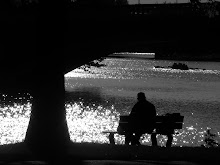Una caminata sabatina en un día soleado es una de las mejores formas de conocer un lugar, apropiarse de él, percibir a grandes rasgos (si bien aún con ojos extranjeros) pistas de sus vicios y virtudes… A eso nos dedicamos con Djudju y Widhar luego de un contundente desayuno en el Mercado Ben Tanh: a impregnarnos de Saigón.
Caminar sus calles implica encontrarse a cada paso con su gente, sortear motocicletas y automóviles al tratar de pasar las calles, acostumbrarse al ruido constante, a la vida en cada rendija. Y a cada paso se encuentra una postal, imágenes inolvidables del día a día del Vietnam urbano. Muchas mujeres usan sombreros cónicos, y los vendedores ambulantes llevan sobre los hombros palos de bambú en cuyos costados atan telas en las cuales sostienen los productos.

En el mercado y en la calle encontramos monjes budistas caminando, casi flotando con sus túnicas mientras la gente, las mascotas, las motos y bicicletas, mientras esta rabiosa Ciudad Ho Chi Minh pasa a su lado, sorteándolo con un profundo respeto. Djudju se apresuró a ir a la tienda y comprar dos almuerzos para llevar, y corrió a buscar a uno de los monjes para regalarle la comida. Widhar me explicaría luego que en Indonesia, especialmente en algunos pueblos tradicionales, aún está muy viva esa costumbre: los monjes son casi venerados, y como no pueden trabajar, cuando salen a caminar por las aldeas la gente se les acerca, a veces de rodillas, para ofrecerles comida y bebida. Los monjes aceptan los presentes, y lo retribuyen con oraciones y bendiciones.

No entramos al Museo de Bellas Artes porque llegamos en la mitad de lo que parecía ser un gran evento social. Los invitados llegaban en su mayoría en motos, y el guardia en la puerta se encargaba de controlar el ingreso: tomaba nota de la placa de cada moto que ingresaba, y en lugar de darles un ticket de parqueo escribía sobre la moto un código con tiza. Decidimos que no estábamos debidamente vestidos para la ocasión, y enrumbamos por un callejón caprichoso, lleno de tienditas de artesanías (con figuras de Buda dominando casi todos los sitios) y otros servicios, incluyendo un sitio para reparación de cámaras al cual pronto enviaré la mía que falta que le hace un buen ABC.
Desembocamos en lo que habrá de convertirse en nuestra heladería favorita: Fanny Icecream. El verídico sitio BBB. No solo es cómodo y con la ventilación y la sombra adecuada para guarecerse del sol del medio día, sino que tiene una asombrosa variedad de sabores, especialmente helados de frutas locales que en mi vida he probado. Además de los precios más que razonables, el lugar se da el lujo de decorar lo que sirve con un gusto que bien que les hace falta a muchos de los lugares que conozco por los Estados Unidos (por ejemplo, la copa de mi sorbete traía una orquídea, y la de Djudju un sombrero cónico vietnamita en miniatura).
Bien nutridos, a retomar la caminata. Pasamos por la (ahora ya bastante familiar) estatua de Ho Chi Minh, frente a la cual están ubicadas varias galerías de arte. Las pinturas locales tienden a ser muy lindas, pero al parecer los vietnamitas también tienen cierto gusto por tratar de reproducir famosas obras maestras occidentales, tarea en la que, deberé decir, tienen aún mucho potencial para mejorar…
Vagabundeamos por veredas concurridas en donde los cables de electricidad cuelgan tan bajo que este cristiano, que lo que no tiene de chiquito lo tiene de distraído, corre serio peligro de quedarse colgado de un momento a otro. Exploramos un par de parques, en donde la gente se sienta en las bancas y en las veredas, pero nunca en el césped: está prohibido por las autoridades. Y bajo una luna preciosa, casi llena, terminamos en la oficina de correos de la ciudad, un precioso edificio construido por los franceses en el sigo XIX, fuera del cual vendedores ambulantes ofrecen pequeñas colecciones de estampillas, monedas y billetes vietnamitas que mi vocación de coleccionista simplemente no pudo resistir.

La caminata también nos reveló el lado menos luminoso de Vietnam: su pobreza. Hay mendigos, talvez no tantos como en Loja, Quito o Guayaquil en algunas épocas del año, pero los hay, y gente durmiendo en las calles. Está ahí y es muy penosa, pero deberé decir que no es tan extrema ni tan chocante como las cosas que he visto en América Latina. Quizás allá es más fácil ver los contrastes entre los que muchos tienen y los que nada tienen. Aquí no tanto: es, después de todo, una sociedad mucho más igualitaria. Mi jornada por la Conchinchina está entrando ahora en una nueva etapa, más de observación e introspección, de la que espero cosechar lecciones de vida, de esas que te sirven en los momentos menos esperados.



























